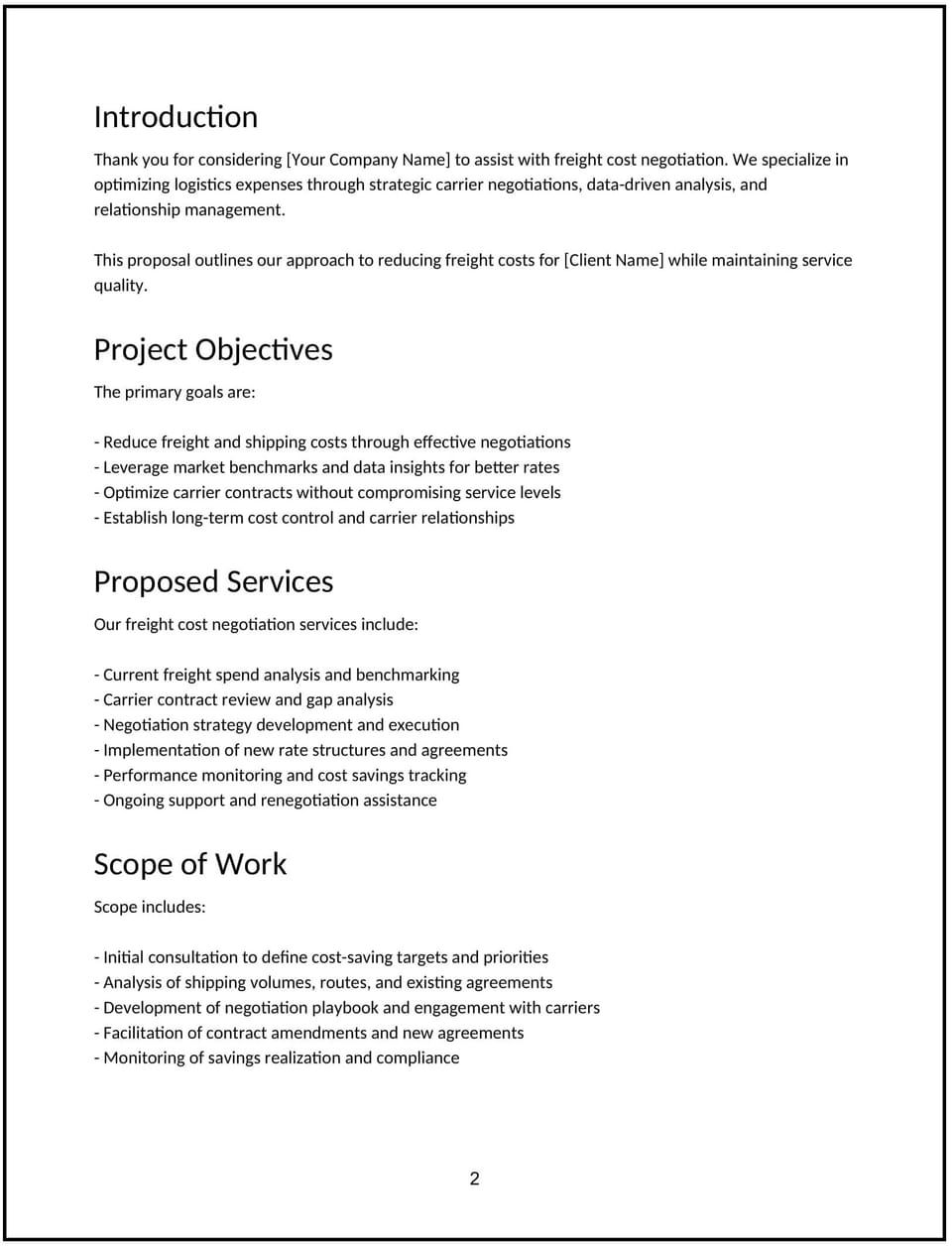Freight cost negotiation proposal: Free template

Customize this free freight cost negotiation proposal with Cobrief
Open this free freight cost negotiation proposal in Cobrief and start editing it instantly using AI. You can adjust the tone, structure, and content based on your shipping volume, vendor relationships, and target savings. You can also use AI to review your draft — spot gaps, tighten language, and improve clarity before sending.
Once you're done, send, download, or save the proposal in one click — no formatting or setup required.
This template is fully customizable and built for real-world use — ideal for logistics teams, procurement consultants, or freight brokers negotiating better rates with carriers. Whether you manage shipping in-house or offer this as a service, this version gives you a structured head start and removes the guesswork.
What is a freight cost negotiation proposal?
A freight cost negotiation proposal outlines how you plan to negotiate lower shipping rates with carriers or third-party logistics providers. It includes the current freight profile, negotiation strategy, expected savings, and terms of engagement.
Use this proposal to:
- Pitch freight cost reduction as a standalone service or part of broader supply chain optimization
- Show your understanding of the client’s shipping patterns and leverage points
- Provide a structured plan for benchmarking, negotiating, and locking in lower rates
- Build trust by showing expected ROI and low operational risk
This type of proposal is commonly used by logistics consultants, freight brokers, and supply chain managers working with mid-market or enterprise businesses.
Why use Cobrief to edit your proposal
- Edit the full proposal instantly: No setup or formatting — open and customize in-browser.
- Use AI to tailor based on volume or regions: Adjust your scope and strategy to match international or domestic freight.
- Run an AI-powered review: Catch vague claims, missing steps, or unclear ROI figures.
- Apply AI suggestions in one click: Accept edits manually or all at once.
- Save, send, or download in seconds: Share the proposal as a live link, email, or downloadable PDF.
When to use this proposal
- When pitching freight cost optimization services to a new client: Show how you’ll reduce shipping expenses without operational risk.
- When responding to a request for logistics consulting or rate reviews: Submit a structured proposal with deliverables and ROI.
- When renegotiating rates on behalf of a client: Formalize your process and create alignment before you engage with carriers.
- When offering a performance-based or flat-fee freight review: Provide clear terms, timeline, and expected cost savings.
- When onboarding a logistics client with inconsistent rate structures: Establish a baseline and propose improvements.
What to include in a freight cost negotiation proposal
- Client shipping profile: A summary of current freight spend, shipping lanes, volumes, and carriers used.
- Objectives: Clear goals such as rate reductions, contract consolidation, or fuel surcharge management.
- Negotiation strategy: A high-level plan for carrier benchmarking, proposal review, and rate renegotiation.
- Scope of work: Specific activities such as data analysis, RFP management, rate comparison, and contract review.
- Timeline: Duration of the engagement and key milestones — from kickoff to implementation.
- Expected outcomes: Estimated savings, operational impact, and risk profile.
- Pricing: Whether flat-fee, hourly, or success-based — include how fees are calculated.
- Next steps: A clear CTA — such as reviewing data access, scheduling a kickoff call, or approving the scope.
How to write an effective freight cost negotiation proposal
- Tie cost savings to business value: Show how rate reductions support margin improvement, cash flow, or growth.
- Be upfront about what’s negotiable: Explain which cost levers can realistically be improved and how.
- Include proof points: Share examples of past savings or metrics achieved with similar clients.
- Avoid vague promises: Use realistic benchmarks instead of generic claims like “up to 40% off.”
- Make the pricing model clear: Whether performance-based or fixed, be transparent about how you charge.
- End with a strong CTA: Make the next step obvious and actionable — whether it’s data access or scheduling a review.
Frequently asked questions (FAQs)
Can I use this for domestic and international freight?
Yes — the template works for any mode (LTL, FTL, ocean, air), and can be customized for any geography.
What if I don’t have full access to the client’s data yet?
You can use this proposal to initiate the engagement and request the necessary data as part of the kickoff phase.
Can I include a performance-based fee structure?
Absolutely. Many providers offer success-based pricing — you can include that model in the pricing section.
Can I download this as a branded PDF?
Yes — once you’ve edited the proposal, you can download a professional PDF in one click.
This article contains general legal information and does not contain legal advice. Cobrief is not a law firm or a substitute for an attorney or law firm. The law is complex and changes often. For legal advice, please ask a lawyer.